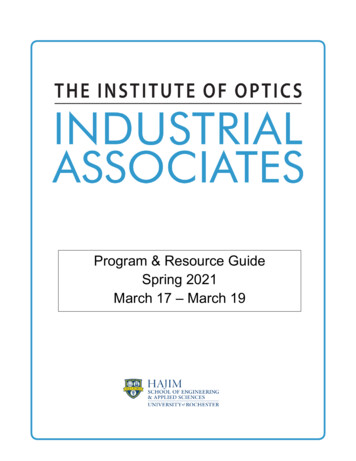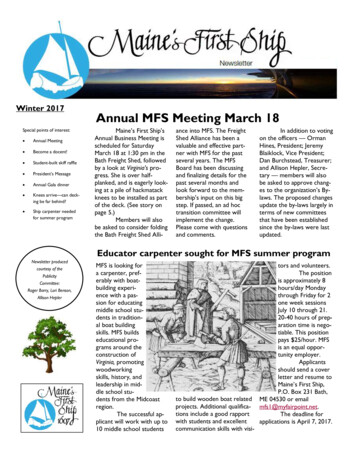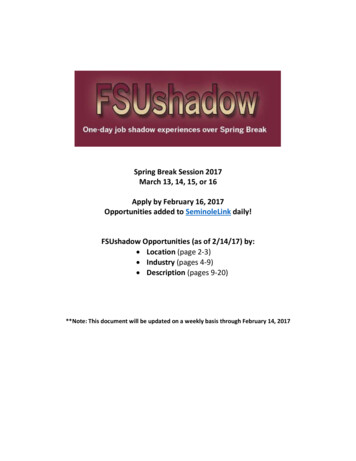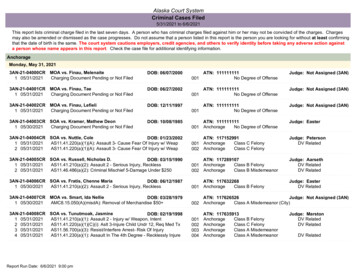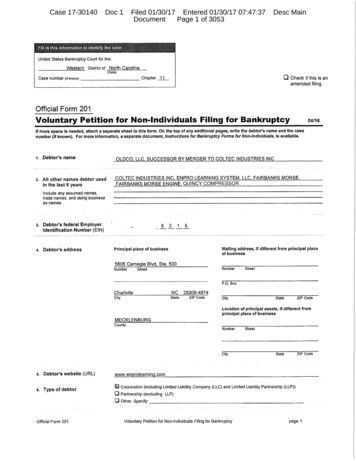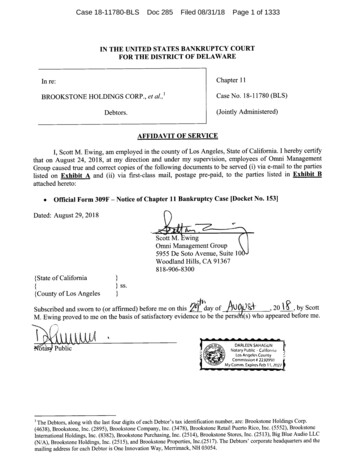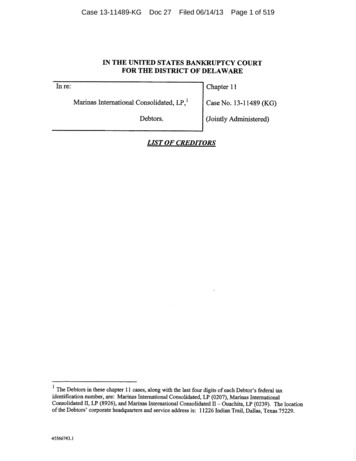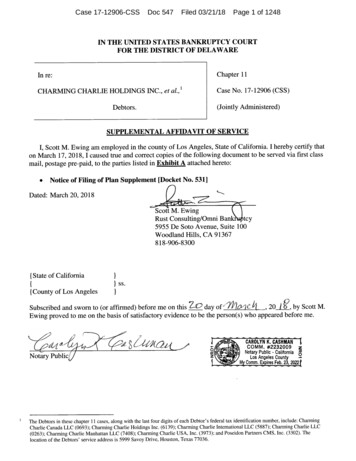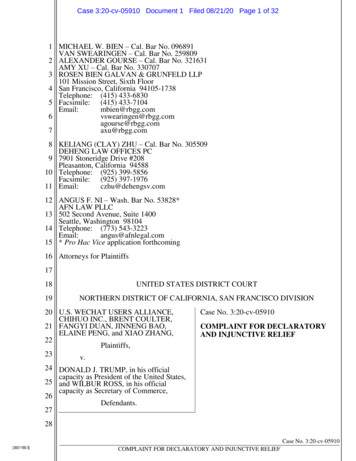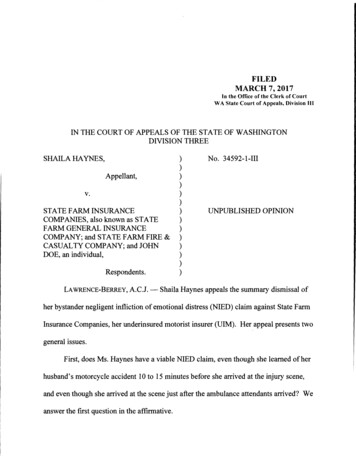
Transcription
FILEDMARCH 7, 2017In the Office of the Clerk of CourtWA State Court of Appeals, Division IllIN THE COURT OF APPEALS OF THE STATE OF WASHINGTONDIVISION THREESHAILA HA YNES,))))Appellant,V.No. 34592-1-III)STATE FARM INSURANCECOMPANIES, also known as STATEFARM GENERAL INSURANCECOMPANY; and STATE FARM FIRE &CASUAL TY COMPANY; and JOHNDOE, an individual,Respondents.LAWRENCE-BERREY, A.CJ. -)))))))))UNPUBLISHED OPINIONShaila Haynes appeals the summary dismissal ofher bystander negligent infliction of emotional distress (NIED) claim against State FarmInsurance Companies, her underinsured motorist insurer (UIM). Her appeal presents twogeneral issues.First, does Ms. Haynes have a viable NIED claim, even though she learned of herhusband's motorcycle accident 10 to 15 minutes before she arrived at the injury scene,and even though she arrived at the scene just after the ambulance attendants arrived? Weanswer the first question in the affirmative.
No. 34592-1-IIIHaynes v. State FarmSecond, does Ms. Haynes's action against State Farm involve a coverage disputeor a claim dispute? We conclude that her action involves a claim dispute and deny herrequest for reasonable attorney fees and costs under Olympic Steamship. 1 We thereforereverse in part and affirm in part the trial court's summary judgment order.FACTS 2Randy Haynes and two friends were riding their motorcycles on Interstate 90, westof Ellensburg, when an erratically driven van attempted to pass them. Shortly after thevan passed, it slammed on its brakes and forced Mr. Haynes's motorcycle off the road.Mr. Haynes crashed his motorcycle and suffered traumatic injuries to his head and chest.The van briefly pulled over, but then sped away. The van's driver never was identified.Jennifer Fordham was one of the two friends that day riding motorcycles with Mr.Haynes. Ms. Fordham knew that Mr. Haynes's wife, Shaila Haynes, was with NicoleCrossett at her house in Ellensburg. Within three minutes of the accident, Ms. Fordhamcalled Ms. Crossett and told her, '"Randy went down on his motorcycle. He's been in anaccident."' Clerk's Papers (CP) at 303. Ms. Fordham described her location as near1Olympic Steamship Co. v. Centennial Ins. Co., 117 Wn.2d 37, 811 P.3d 673(1991).2Because the trial court dismissed Ms. Haynes's NIED claim on summaryjudgment, we state the facts and all reasonable inferences in her favor.2
No. 34592-1-111Haynes v. State FarmIndian John rest stop, and told Ms. Crossett that she and Ms. Haynes needed to get therequickly.Ms. Crossett then told Ms. Haynes that there was an accident and her husband hadgone down on his motorcycle. Ms. Haynes had a bad feeling about the accident, but"honestly didn't know" what to expect. CP at 49. The two immediately got into Ms.Crossett's truck and sped to the accident scene.Ms. Haynes and Ms. Crossett arrived 10 to 15 minutes after the call. Anambulance arrived just before them.One of the ambulance attendants prepared a report that described the initial scene.The report notes that Mr. Haynes was laying in the median, wearing a leather jacket,denim pants, and a half helmet with the chin strap still attached and "the helmet hadsignificant damage." CP at 314. Prior to Ms. Haynes's arrival, someone had turned Mr.Haynes over so his mouth was not in the dirt. The attendants had also removed hishelmet and also his shirt, presumably to assist with resuscitation, and had placed abackboard under him. Although he had been turned over and placed on a backboard, Mr.Haynes had not been moved from his original location.Ms. Haynes noticed her husband's "motorcycle was . crumbled up in pieces andin parts, strewn all over, and he was further on down from the motorcycle." CP at 47.She ran to him, knelt down where he laid, took his hand, and spoke to him. He did not3
No. 34592-1-111Haynes v. State Farmrespond. She noticed "scrapes and blood up on his head," and that his helmet wasdamaged. CP at 52. The attendant's report described Mr. Haynes as having sustainedblunt force trauma to his head and chest. Ms. Haynes suffered emotionally as "a result ofseeing [her husband] lying there in the median." CP at 191.The ambulance attendants then directed everyone to give them room, and theycontinued to care for Mr. Haynes. After about 10 more minutes, the attendants loadedMr. Haynes into an ambulance to take him to a nearby field so he could be airlifted byhelicopter to Harborview Medical Center in Seattle. Ms. Haynes asked to ride with them,but was told she could not. Once Mr. Haynes was placed in the ambulance, Ms. Crossettand Ms. Haynes sped off to Harborview. About 30 minutes after the two arrived atHarborview, a doctor informed Ms. Haynes that her husband had died.Months prior to her husband's fatal accident, Ms. Haynes was diagnosed withbreast cancer. According to her attending physician, "It is my sincere belief that Shailahas suffered immense mental and physical distress due to her diagnosis and the loss ofher husband." CP at 320.ProcedureMs. Haynes made a claim against her State Farm UIM policy. State Farm paid the 50,000 policy limit for Mr. Haynes's death. Ms. Haynes then sought additionalcompensation in the form of a bystander NIED claim. State Farm denied her claim on4
No. 34592-1-IIIHaynes v. State Farmthe basis that a bystander NIED claim could not be sustained by one who learned of anaccident before coming to the accident scene.Ms. Haynes filed suit. After discovery occurred, the trial court considered anumber of motions and cross motions for summary judgment. The trial court ruled as amatter of law that Ms. Haynes did not have an actionable bystander NIED claim. Thetrial court concluded that only a person who "unwittingly" arrives at an injury scenecould recover under that theory, and Ms. Haynes had arrived at the injury scene after shefirst learned of her husband's accident. Ms. Haynes timely appealed.ANALYSISThis court reviews summary judgment orders de novo, engaging in the sameinquiry as the trial court. Smith v. Safeco Ins. Co., 150 Wn.2d 478,483, 78 P.3d 1274(2003) (quoting Jones v. Allstate Ins. Co., 146 Wn.2d 291, 300, 45 P.3d 1068 (2002)).Summary judgment is appropriate only if there is no genuine issue as to any material factand the moving party is entitled to judgment as a matter oflaw. CR 56(c). All facts andreasonable inferences are considered in a light most favorable to the nonmoving party.Berger v. Sonne/and, 144 Wn.2d 91, 102-03, 26 P.3d 257 (2001). When reasonableminds can only reach one conclusion, questions of fact may be determined as a matter oflaw. Ruffv. King County, 125 Wn.2d 697, 704, 887 P.2d 886 (1995).5
No. 34592-1-111Haynes v. State Farm1.BYSTANDER NIED CLAIMS IN WASHINGTONMs. Haynes contends the trial court erred in dismissing her bystander NIED claimon summary judgment.a.General rule: present at the scene or arrive shortly thereafterA bystander NIED action is a "limited, judicially created cause of action thatallows a family member a recovery for 'foreseeable' intangible injuries caused byviewing a physically injured loved one shortly after a traumatic accident." Colbert v.Moomba Sports, Inc., 163 Wn.2d 43, 49, 176 P.3d 497 (2008). The plaintiff must bepresent at the scene of the accident or arrive shortly thereafter. Id. at 55.Hegel v. McMahon, 136 Wn.2d 122, 132, 960 P.2d 424 (1998) discussed thecontours of the "shortly thereafter" limitation, and adopted the following rule: "We .hold that a family member may recover for emotional distress caused by observing aninjured relative at the scene of an accident after its occurrence and before there is asubstantial change in the relative's condition or location." The purpose of the Hegel rulewas to narrow the class of claimants to those who are present at the scene before thehorror of the accident has abated. Id.b.Colbert clarification of the ruleA decade after Hegel, the Colbert court sought to clarify the contours of itsjudicially created cause of action. In Colbert, Jay Colbert and his wife were awakened by6
No. 34592-1-111Haynes v. State Farma 3:00 a.m. telephone call from their daughter Denise's boyfriend. Colbert, 163 Wn.2d at46. The boyfriend told them that Denise had disappeared from the back of a friend's boatat a nearby lake and a search was taking place for her. Id. Mr. Colbert took his otherchildren to a neighbor's house and drove to the lake that was about five minutes away.Id. By that time, police cars, ambulances, and the fire department were at the scene. Id.Mr. Colbert watched the search taking place from a friend's dock on the lake. Mr.Colbert hoped Denise would be found alive because she was an outstanding athlete and astrong swimmer. Id.Almost three hours later, at around 6:00 a.m., rescuers found Denise's body. Id.About 10 minutes later, Mr. Colbert saw a buoy pop to the lake's surface. Id. at 46-47.He could hear rescuers on the lake talking, and knew the buoy was tied to his daughter'sbody. Id. at 47. From about 100 yards, and in the dim light, he could see his daughter'sbody being pulled onto the rescue boat, and rescue workers moving her body on the boat.Id. Once the rescue boat came to shore, Mr. Colbert saw police bring a stretcher from anearby ambulance, place a sheet over his daughter's body, and take her body away. Id.Denise had died three hours earlier. Her direct cause of death was drowning, partiallydue to breathing carbon monoxide fumes from the boat. Id.Mr. Colbert filed suit against various defendants. In addition to other claims, hebrought a personal claim for bystander NIED. Id. The parties moved for summary7
No. 34592-1-111Haynes v. State Farmjudgment on various issues, including whether Mr. Colbert had a viable claim forbystander NIED. The trial court dismissed that claim, reasoning that the crux of such aclaim was the requirement that a bystander relative had to be "' present within a shortperiod of time [after the accident] to view the victim's suffering."' Id. at 48. The trialcourt reasoned that Mr. Colbert "' did not witness any pain, suffering or the like.'" Id.Mr. Colbert appealed, and the Court of Appeals affirmed. Id. The Supreme Courtgranted Mr. Colbert's petition for review.The Colbert court first reviewed the history of bystander NIED claims inWashington.We [earlier] observed . that while a bright line rule limitingrecovery "to those who witnessed the accident is attractive in its simplicity. it draws an arbitrary line that served to exclude plaintiffs withoutmeaningful distinction." The tort of negligent infliction of emotionaldistress rests on the fact the plaintiffsuffers emotional trauma stemmingnot only fromwitnessing the transition from health to injury, but also fromwitnessing the aftermath of an accident in all its alarming detail . .The essence of the tort is the shock caused by the perceptionof an especially horrendous event. . . . The kind of shock thetort requires is the result of the immediate aftermath of anaccident. It may be the crushed body, the bleeding, the criesofpain, and, in some cases, the dying words which are reallya continuation of the event. The immediate aftermath may bemore shocking than the actual impact.Accordingly, in deciding the scope of the tort, we sought to identifya rule that permitted recovery for those who suffer emotional distressbecause they personally experienced the immediate aftermath of anaccident that is in reality a continuation of the event. .8
No. 34592-1-111Haynes v. State FarmWe concluded that in Washington a cause of action for negligentinfliction of emotional distress is recognized "where a plaintiff witnessesthe victim's injuries at the scene of an accident shortly after it occurs andbefore there is a material change in the attendant circumstances."Id. at 54-55 (citations omitted) (some emphasis in original).In applying the standards described above to the facts, the Colbert court reasoned:When Mr. Colbert arrived, the accident had already occurred-hedid not observe his daughter's suffering or her condition while she wasdrowning. Although he may have arrived within a chronologically shorttime of her death, at no time did he personally experience conditions thatcan be said to be a continuation of"' an especially horrendous event'"involving conditions analogous to seeing a "' crushed body [or] bleeding"'or hearing "' cries ofpain [or] dying words.'"Id. at 57 (alterations and some emphasis in original).The Colbert court also addressed Mr. Colbert's argument that the Court ofAppeals erroneously imposed a requirement that the plaintiff arrive "unwittingly" at theaccident scene. Id. at 59. The Colbert court analyzed the Pennsylvania case relied on bythe Court of Appeals, Mazzagatti v. Everingham, 512 Pa. 266, 516 A.2d 672 ( 1986). TheMazzagatti court rejected the rule in states such as Washington and held that a bystanderNIED plaintiff must be at the scene when the accident occurs. Colbert, 163 Wn.2d at 60.The Mazzagatti court explained that plaintiffs who arrive at the scene after first learningof the injury have a buffer that insulates them from the full impact of observing theaccident scene. Id. Although the Mazzagatti court rejected the "shortly thereafter" rule9
No. 34592-1-111Haynes v. State Farmin states such as Washington, the Colbert court held that whether the plaintiff arrived atthe accident unwittingly is an appropriate "consideration" when determining whether heor she can bring a bystander NIED claim. Id.In Colbert, Mr. Colbert knew his daughter's body was lost in the lake, and nearlythree hours passed before he saw her lifeless body brought onto the rescue boat. At someearly point in these three hours, he likely knew his daughter had drowned, and he hadsubstantial time to brace himself for the full impact of seeing his daughter's body broughtonto the boat.We contrast Colbert's facts to the facts presented here. Ms. Crossett told Ms.Haynes that her husband was in a motorcycle accident along Interstate 90. Although Ms.Haynes feared it might be bad, she "honestly didn't know" what to expect. CP at 49.Also, she did not have long to brace herself for what she might see. When she arrived 10to 15 minutes after hearing of the accident, she saw her husband's motorcycle and partsstrewn all over, and her husband's body in the median laying almost lifeless, with bloodcoming from his head. A reasonable juror could find that Ms. Haynes did not have thetime or opportunity to brace herself for the full impact of what she saw. We conclude thetrial court erred when it summarily dismissed Ms. Haynes's bystander NIED claim on thebasis of what Ms. Crossett told her 10 to 15 minutes earlier.10
No. 34592-1-111Haynes v. State FarmThe Colbert court additionally addressed Mr. Colbert's argument that the Court ofAppeals erroneously imposed a requirement that the plaintiff be physically present at thescene of the accident before emergency personnel arrive. Id. at 60-61. The Colbert courtfirst analyzed the New Mexico case relied on by the Court of Appeals, Gabaldon v. Jay-Bi Prop. Mgmt., Inc., 1996-NMSC-055, 122 N.M. 393,925 P.2d 510. After analyzingthe case, the Colbert court said, "Gabaldon's requirement that the plaintiff be presentbefore emergency personnel arrive is not consistent with our cases defining the 'shortlythereafter' requirement. . . . Accordingly, we disapprove of the Court of Appeals'reliance on . Gabaldon." Colbert, 163 Wn.2d at 61-62.Similarly, we do not believe that Ms. Haynes's arrival at the injury scene just afterthe ambulance negates her claim. Here, Ms. Haynes arrived at the injury scene beforethere was a material change in her husband's location or condition. First, her husband'sbody had not been moved, other than to roll him over so he could breathe. Second, theremoval of Mr. Haynes's shirt and helmet, and the placement of a backboard under him,in no way reduced the visual shock of the accident scene. See Hegel, 136 Wn.2d at 132(purpose of "shortly thereafter" rule is to narrow class of claimants to those present at thescene before the horror of the accident has abated).11
No. 34592-1-111Haynes v. State Farm2.DISPUTE CLASSIFICATIONMs. Haynes contends that this dispute is a coverage dispute, not a claim dispute.As a coverage dispute, Ms. Haynes would be entitled to attorney fees and costs. "UnderOlympic Steamship, ' [a]n insured who is compelled to assume the burden of legal actionto obtain the benefit of its insurance contract is entitled to attorney fees.'" Matsyuk v.State Farm Fire & Cas. Co., 173 Wn.2d 643,658,272 P.3d 802 (2012) (alteration inoriginal) (quoting Olympic Steamship, 117 Wn.2d at 54).In Washington, a UIM insured is legally entitled to recover and a UIM insurerrequired to pay only to the extent that liability could be imposed against an uninsuredtortfeasor. Mcillwain v. State Farm Mut. Auto. Ins. Co., 133 Wn. App. 439, 446, 136P.3d 135 (2006). UIM insurance carriers "are not compelled to pay when the samerecovery could not have been obtained from an uninsured tortfeasor." Dayton v. FarmersIns. Group, 124 Wn.2d 277,281, 876 P.2d 896 (1994). Olympic Steamship does notapply when the insurer contests questions such as its liability in tort or the amount itshould pay. Matsyuk, 173 Wn.2d at 660.State Farm has always admitted it would cover a valid bystander NIED claim.State Farm simply disputed it was liable on Ms. Haynes's bystander NIED claim becauseMs. Haynes learned of her husband's accident before she arrived at the injury scene.Although we ultimately determined that Ms. Haynes does state a viable bystander NIED12
No. 34592-1-111Haynes v. State Farmclaim under the specific facts discussed, this does not tum a claim dispute into a coveragedispute. Ms. Haynes was not compelled to sue to obtain coverage for a bystander NIEDclaim, she was compelled to sue to establish State Farm's liability on her bystander NIEDclaim. The trial court correctly concluded that this dispute is a claim dispute.Reversed in part; affirmed in part.A majority of the panel has determined this opinion will not be printed in theWashington Appellate Reports, but it will be filed for public record pursuant toRCW 2.06.040.jWE CONCUR:Pennell, J.13
FARM GENERAL INSURANCE ) COMPANY; and STATE FARM FIRE & ) CASUAL TY COMP ANY; and JOHN ) DOE, an individual, ) ) Respondents. ) LAWRENCE-BERREY, A.CJ. - Shaila Haynes appeals the summary dismissal of her bystander negligent infliction of emotional distress (NIED) claim against State Farm Insurance

